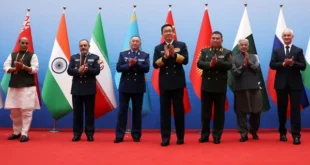- Earlier this month, the Supreme Court announced that it would examine whether minor girls, as young as 15 years, can marry on the basis of custom or personal law when such marriages are considered an offence in statutory law.
- The legal age for marriage is 18 years for women and 21 years for men. Marriage below this age is considered to be child marriage, and hence an offence.
- In 2017, the Supreme Court had ruled that sexual intercourse by a man with his wife, who is below 18 years, is rape, reading down Exception 2 to Section 375 (rape) of the Indian Penal Code which allowed the husband of a girl child — between 15 and 18 years of age — to have non-consensual sex with her.
What is the Supreme Court looking at?
- On January 13, the Supreme Court said it would examine whether girls as young as 15 years old can enter into wedlock if their personal law allows it.
- A Bench led by Chief Justice of India D.Y. Chandrachud issued a formal notice on a petition filed by the National Commission for Protection of Child Rights (NCPCR) against a recent order of the Punjab and Haryana High Court that said a girl, on attaining puberty or the age of 15 years and above, could be married on the basis of Muslim personal law, irrespective of the provisions of the Protection of Children from Sexual Offences (POCSO) Act, 2012.
- The Supreme Court said the High Court order would not act as a judicial precedent for other courts.
- The NCPCR argued that when girls as young as 14 and 15 are being married off, a plea of personal law and custom cannot be used when the POCSO Act and the Indian Penal Code make such marriages an offence.
- The Supreme Court has also appealed to Parliament to lower the age of consent under the POCSO Act and the IPC which set it at 18 years, thus criminalising all adolescent consensual sexual activity. Last December, the government told Parliament that it does not plan to do that yet.
What are the various laws that govern marriage in India?
- The Prohibition of Child Marriage (Amendment) Bill, 2021 has sought to amend the Prohibition of Child Marriage Act (PCMA), 2006, to increase the minimum age of marriage for women from 18 to 21 years.
- In December 2021, it was referred to a parliamentary standing committee for further deliberations, and it has already got three extensions to submit its report, the last being in October 2022.
- Last December, the Supreme Court had asked the government to respond to another petition filed by the National Commission for Women (NCW) to make the minimum age of marriage for Muslim women on par with persons belonging to other faiths.
- The NCW, like the NCPCR, had raised the question whether personal law could override statutory provisions of the POCSO Act and other laws. The NCW petition stated that under the Indian Christian Marriage Act, 1872, Parsi Marriage and Divorce Act, 1936, Special Marriage Act, 1954 and Hindu Marriage Act, 1955, the minimum age of marriage for a man is 21 years and for a woman it is 18 years.
- “However, under the Muslim personal law in India, persons who have attained puberty are eligible to get married i.e. on attaining the age of 15 years, while they are still minor,” it said.
What has the Assam government decreed?
- The Assam Cabinet recently announced that men who marry minor girls would be booked under stringent laws prescribing imprisonment from two years to life.
- Citing the National Family Health Survey-5 report, Chief Minister Himanta Biswa Sarma said an average of 31.8% of girls in Assam get married at the “prohibited age” and 11.7% become mothers before adulthood. The national average is 23.3% and 6.8% respectively.
Which are the other States where child marriage is high?
- An analysis of Child Marriage in India based on Census 2011 by Young Lives, India and NCPCR in June 2017 identified 70 districts spread across 13 States including Assam, Bihar, Gujarat, Jharkhand, Karnataka, Madhya Pradesh, Maharashtra, Rajasthan, Uttar Pradesh and West Bengal where prevalence of child marriage is high. According to activists and health workers, targeted interventions including awareness campaigns on reproductive health and provisions of the law, are being carried out to prevent and reduce child marriage, and though NFHS-5 data show improvement, there’s a lot of ground left to be covered.
- In Jharkhand, according to NFHS-5 (2021), 32.2% women married before they turned 18 compared to 37.9% in 2016 (NFHS 4); in West Bengal, 41.6% women got married before they turned 18 (NFHS-5) and the percentage was the same in NFHS-4; Madhya Pradesh has seen a reduction in child marriage (from 32.4% in NFHS-4 to 23.1% in NFHS-5), though the infant mortality rate is high — 41.3 per 1000 live births.
What are the effects of early marriage?
- The Young Lives, India-NCPCR study pointed out that girls who got married before turning into adults lacked reproductive choices and were denied a host of other rights, including education, autonomy and often a lack of livelihood.
- With 59% of Indian girls in the 15-19 group suffering from anaemia — it stood at 54% in NFHS-4 — early child-bearing could result in poor maternal and child health and poor nutritional status.
- Health experts tie maternal health to another crucial factor — education. The national percentage of women with 10 or more years of schooling is 41% (NFHS-5) compared to 35.7% in NFHS-4; the data varies from State to State.
- In West Bengal, according to NFHS-5, 32.9% of women have finished 10 or more years of schooling. In two villages of Birbhum district in West Bengal that the anthropologist Mukulika Banerjee has studied since 1998, she observed that while girls continued to be married off early for a variety of reasons, those that had completed school seemed to be making the radical decision to have only one child.
- They said they would prefer to raise one child with care, and were able to help them with homework, provide better nutrition and so on.
Are provisions of the PCMA misused?
- Women’s rights activists point out that parents often use the PCMA to punish their daughters who marry against their wishes or elope to evade forced marriages, domestic abuse, and lack of education possibilities.
- Hence, within a patriarchal setting, it is more likely that the change in the age limit will increase parents’ authority over young adults.
- A 2008 Law Commission report on family law reform recommended a uniform age of marriage for boys and girls at 18 years and not 21.
- It held that since 18 is the age at which a citizen can vote, they should be allowed to marry at that age too.
SOURCE: THE HINDU, THE ECONOMIC TIMES, PIB
 Chinmaya IAS Academy – Current Affairs Chinmaya IAS Academy – Current Affairs
Chinmaya IAS Academy – Current Affairs Chinmaya IAS Academy – Current Affairs



